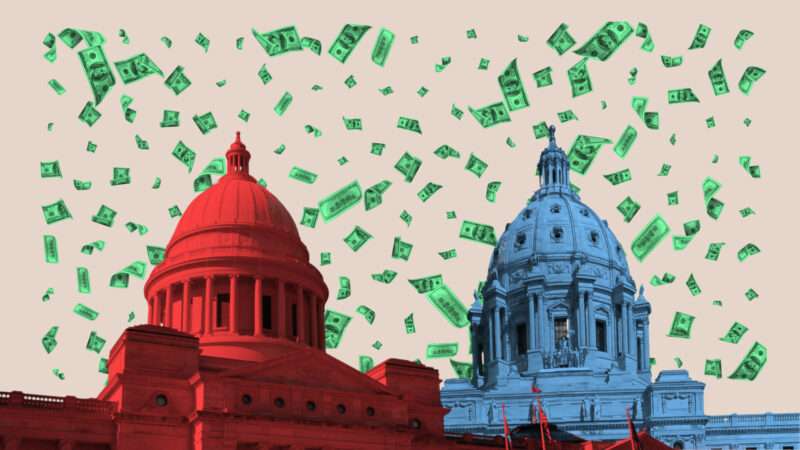
Two years after Congress authorized a hugely expensive bailout of state and local governments as part of a COVID-era emergency spending bill, most of the money still hadn't been spent.
Perhaps the bailout wasn't even needed in the first place?
In a new report, the Government Accountability Office (GAO) found that states (including Washington, D.C.) had spent just 45 percent of the funding they had received through the Coronavirus State and Local Fiscal Recovery Funds program, a $350 billion line item within the $2 trillion American Rescue Plan Act (ARPA), which passed in March 2021. Local governments had reported spending just 38 percent of their funds received through the same program.
Those figures are based on mandatory reports filed quarterly with the Treasury and reflect spending through the end of March 2023, two years after the bailout was approved by Congress.
"The new GAO study confirms that the ARPA spending was not needed," Chris Edwards, chair of fiscal studies at the Cato Institute, tells Reason. "By the fall of 2020, it was clear that the states were in good fiscal shape and not facing Armageddon as many policymakers were claiming. They did not need federal handouts."
Edwards had argued against the bailout of state and local governments during the pandemic, and he wasn't alone. Before the American Rescue Plan passed, there was widespread skepticism about the proposed bailout, in part because three other pandemic-era spending bills had already sent about $360 billion in aid to states and localities.
The effectiveness of that spending has been repeatedly called into question. In a National Bureau of Economic Research working paper published in June 2022, a trio of researchers found that pandemic-era aid distributed to state and local governments had cost taxpayers about $855,000 per job saved. The stimulus spending had only "a modest impact on government employment and has not translated into detectable gains for private businesses or for states' overall economic recoveries," concluded University of California, San Diego economists Jeffrey Clemens and Philip Hoxie and American Enterprise Institute senior fellow Stan Veuger, the paper's three authors.
"Even the unstated assumption behind these handouts—that Washington should step in if there are dips in state revenue—is badly flawed," wrote David Ditch and Richard Stern, policy analysts at the Heritage Foundation, in a report last month that highlighted the state and local bailout among other wasteful COVID-era programs. "Many states are fiscally mismanaged, and federal bailouts enable them to avoid much-needed discipline."
Indeed, as Reason has reported, a good chunk of the state and local bailout funds were put to questionable use, including subsidizing money-losing, government-owned golf courses. Lots of other governments used the stimulus cash to pad the paychecks of public employees.
Iowa spent $12.5 million of its $4.5 billion cut of the federal bailout on a new baseball stadium near the Field of Dreams movie set. Because that's an essential public health issue, of course.
The new GAO report adds to that list of seemingly frivolous spending. It points out that Michigan "reported spending $25.6 million on a travel marketing and
promotional campaign," allegedly to "respond to the impacts of COVID-19 on tourism." Louisiana, meanwhile, reported spending $115 million to construct roads and bridges.
Tourism is nice and roads are in some ways an essential government function, but the emergency COVID spending was meant to help states address an immediate public health crisis—or to offset the costs of it. It's not at all clear how highway construction was a victim of the pandemic, and "travel marketing" is something that shouldn't be funded with taxpayer dollars no matter where they come from.
If there ever was a need for emergency aid to states and localities, it has obviously long since passed. Edwards points out that state and local tax revenue in the first quarter of 2023 was up 25 percent over the first quarter of 2020—which immediately preceded the onset of the pandemic.
"The states have full treasuries, and so they should give any remaining bailout funds back to Washington," he recommends.
Whether that happens remains to be seen. It's probably more likely that, with so much pandemic-era emergency cash still waiting to be spent, state and local governments will find more silly ways to blow through piles of taxpayer money they never should have gotten their hands on in the first place.
The post The COVID Bailout of State and Local Governments Was Unnecessary appeared first on Reason.com.







